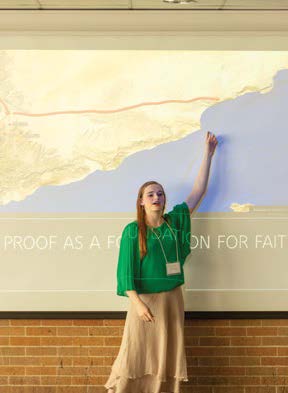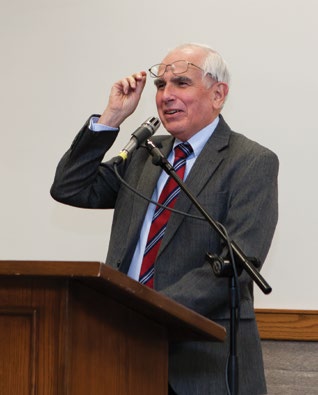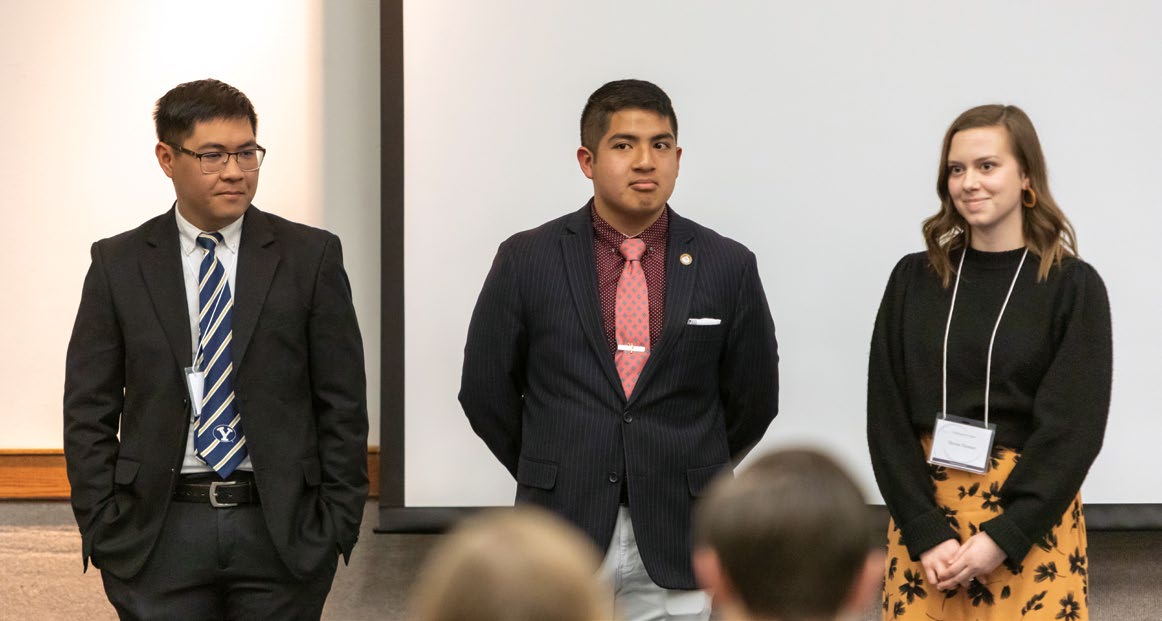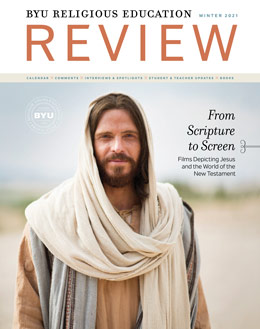"Reward Excellence"
A Brief History of the BYU Religious Education Student Symposium
Casey Paul Griffiths
Casey Paul Griffiths (casey_griffiths@byu.edu) is an assistant teaching professor of Church History and Doctrine at BYU.
 Student giving presentation at Student Symposium.
Student giving presentation at Student Symposium.
In the spring of 1998, Richard E. Bennett attended a new faculty seminar where Henry B. Eyring, then the Commissioner of the Church Educational System, challenged the teachers at BYU to find ways to help their undergraduate students publish their own work. President Eyring felt more opportunities to publish might “help them gain admission to graduate school and also help them prepare for future careers.”[1] While teaching at the University of Manitoba a few years earlier, Dr. Bennett had organized a history-focused symposium for college students, and he felt the time was right to bring a similar forum to the students at BYU.[2] He soon secured the support of Robert L. Millet, the dean of Religious Education, and his department chair, Raymond S. Wright, and was appointed the first chair of the Student Symposium. A planning committee consisting of Todd Parker, John Livingstone, Cynthia Doxey Green, Patty Smith, and a student named Jeremy Wells was appointed to put together the first symposium. With a budget of four thousand dollars to pay for promotion, publication, and a luncheon for the students, the team set to work.
As they worked together, the committee labored to formulate the purpose and aims of the symposium. Dr. Bennett recalled designing the symposium to “improve student writing and research skills; to foster a climate of student scholarship in Church History (soon afterward the symposium was opened to include Ancient Scripture); to reward excellence by providing prizes and awards; and to improve the academic profile of Religious Education.” One goal stood out above the rest, “to provide the rising generation of Latter-day Saint students a forum in which they could express their views and interpretations of Church History at a time when technological advances were exposing more youth to questions about our past.”[3]
The first Student Symposium was held April 1–2, 1999, at the Harman Building on BYU campus. The committee chose forty-eight presenters out of ninety-nine who submitted papers to the symposium. Over the years the symposium was simplified to a one-day event, typically held in February. Students present in several sessions held in the Wilkinson Center, followed by a banquet attended by representatives from several prominent academic organizations including the Mormon History Association, the Maxwell Institute, Book of Mormon Central, the Ensign Peak Foundation, the Interpreter Foundation, and others. Students who submit excellent papers receive prizes ranging from the grand prize of two thousand dollars down to five hundred dollars. Prize-winning papers are published in a volume prepared by the RSC and student authors are often recruited by attendees to publish their papers in academic journals. After twenty years of the symposium, thousands of students have had the opportunity to present, and thousands more have attended.
 Richard Bennett, founder and the first chair of the Student Symposium, wanted to improve student writing and research skills, foster a climate of student scholarship, and improve the academic profile of Religious Education. Photos by Richard B. Crookston.
Richard Bennett, founder and the first chair of the Student Symposium, wanted to improve student writing and research skills, foster a climate of student scholarship, and improve the academic profile of Religious Education. Photos by Richard B. Crookston.
Papers for the symposium cover a wide variety of topics, ranging from Church history to scriptural studies to social issues. Titles of papers from just the last few years include “Reconnecting with the Divine Feminine” (2020), “Helping Eating Disorders through the Gospel” (2016), “Understanding the Disciple’s Path with Game Theoretic Mathematics” (2017), “Disease or Devils: Exploring Mental Illness in the New Testament” (2018), and “Princes Also Shall Worship:’ The History and Conversion of a Tongan Prince” (2018). In 2020 the top prize was awarded to a paper titled “From Animosity to Acceptance: How Early Latter-day Saint Suffragists Redefined America’s View of Latter-day Saints.” Brady Earley, the author of this award-winning paper, remarked, “During a year in which we celebrated the centennial of the passage of the 19th amendment to the U.S. Constitution, I could think of no better group to highlight than those early Latter-day Saint women.”[4]
For some students, the symposium shifted their academic trajectory. Brooke LeFevre was considering changing her major from psychology to history when she first submitted her work to the symposium. “I didn’t know if I love history enough to pursue it as a career, so I decided to write a research paper on a woman who caught my attention, Mary Elizabeth Rollins Lightner,” Brooke later remembered. “I visited archives, and as I tried to piece together the life of this wonderful witness of the Restoration, I fell in love with not only learning history but the historical process. I was hooked, and I was shocked when that paper won second place in the 2018 symposium.” Brooke is now working on a PhD in history.[5]
The symposium provided an opportunity for graduate students to submit papers as well. Quinten Barney submitted a paper titled “The Symbolic and Liminal Function of the Number Three in the Book of Mormon.” He later remembered, “I compared my findings with how the number is used in the Bible and argued that both texts use the number three in much the same way. I was fairly confident my research was original, interesting, and made a significant contribution to Book of Mormon studies.” Quinten was surprised and delighted when he was awarded a thousand-dollar prize from Book of Mormon Central for his paper.[6] Tyler Beagley, another graduate student, submitted a paper comparing King Benjamin’s sermon with Matthew 25. “It was a fantastic experience submitting the paper, getting notified of its acceptance and working further to improve it, and then presenting at the symposium,” Tyler later recalled.[7]
 Student presenters handling questions and answers at the 2020 Student Symposium. Photo by Richard B. Crookston.
Student presenters handling questions and answers at the 2020 Student Symposium. Photo by Richard B. Crookston.
Over the years a number of future faculty members tested the waters of academia as undergraduates through the means of the Student Symposium. Julie Frederick, now an adjunct instructor in Religious Education, remembered, “I presented with another classics student (Jon Rainey) papers that included analyses using our study of the Greek language to better understand the New Testament. I remember being flattered that Frank Judd, who was faculty moderator, praised our engagement with the original language, and our use of it for exegesis.”[8] Josh Sears, now a faculty member in Ancient Scripture, submitted a paper he wrote in a class taught by Jeffrey Marsh. “I had always enjoyed learning about the scriptures,” he remembered, “but his was the first hint that maybe I could do something more serious with what I learned—that encouragement stayed with me after my mission and impacted what courses I took and what career decisions I made.”[9]
Daniel Becerra, another faculty member in Ancient Scripture, recalled that “it provided me an opportunity to apply the skills of academic inquiry that I had cultivated to explore questions about the gospel that were meaningful to me. In this sense, it gave me a glimpse of what the marriage of ‘study’ and ‘faith’ can look like (Doctrine and Covenants 88:118). I learned how fulfilling it was to teach and learn about the gospel using all of the intellectual and spiritual tools available to me.”[10] J. B. Haws, now an associate dean of Religious Education, looks back on his symposium experience with fond memories. “The Student Symposium was really, for me, the first chance to think about and to talk about religious and historical topics in this kind of setting. It opened my mind to new possibilities and ways of thinking. I had a great lunch, great opportunity to interact with the BYU faculty, and a great opportunity to think seriously about important things.”[11]
Symposium alumni now mentor other new students and sharpen their research, writing, and presenting skills. Building on a foundation of twenty years of excellence in student scholarship, the future is bright for the Student Symposium. The symposium marks a bittersweet milestone in 2021 with the departure of Richard Bennett, the founder of the symposium, who retired from Religious Education this year to serve as the director of the Mormon Trail Center in Omaha, Nebraska. But Dr. Bennett leaves behind a rich legacy of mentorship, scholarship, and success. From a spark of inspiration in a faculty meeting to a program that has blessed the lives of thousands in the Church, the Student Symposium has become a modern school of the prophets, a place to “study and learn, and become acquainted with all good books, and with languages, tongues, and people” (Doctrine and Covenants 90:15).
Notes
[1] Richard E. Bennett, “The Religious Education Student Symposium: A Short History” (unpublished, 2021).
[2] Mark D. Ogletree, “The Religious Education Student Symposium,” BYU Religious Education Review, Fall 2014, 24.
[3] Bennett, 1.
[4] Brady Early, email to author, January 13, 2021.
[5] Brooke LeFevre, email to author, January 15, 2021.
[6] Quinten Z. Barney, email to author, January 13, 2021.
[7] Tyler Beagley, email to author, January 13, 2021.
[8] Julie Frederick, email to author, January 11, 2021.
[9] Joshua Sears, email to author, January 19, 2021.
[10] Daniel Becerra, email to author, January 19, 2021.
[11] J. B. Haws, email to author, January 12, 2021.
